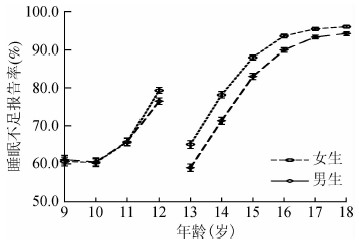文章信息
- 罗冬梅, 徐荣彬, 胡佩瑾, 董彬, 张冰, 宋逸, 马军.
- Luo Dongmei, Xu Rongbin, Hu Peijin, Dong Bin, Zhang Bing, Song Yi, Ma Jun.
- 中国2014年9~18岁汉族学生睡眠不足状况及与体育锻炼的关系研究
- Analysis on the current situation of insufficient sleep and its association with physical exercise among Chinese Han students aged 9-18 years, in 2014
- 中华流行病学杂志, 2018, 39(10): 1298-1302
- Chinese Journal of Epidemiology, 2018, 39(10): 1298-1302
- http://dx.doi.org/10.3760/cma.j.issn.0254-6450.2018.10.002
-
文章历史
收稿日期: 2018-05-01
足量、优质的睡眠对身体恢复[1]和记忆整合[2]有重要意义。研究发现,短期睡眠不足会降低学习效率、削弱认知功能、延长反应时间[3-4];长期睡眠不足是肥胖、糖尿病、心血管疾病、抑郁症和焦虑症的危险因素[5-7]。睡眠的影响因素有很多,其中体育锻炼会影响体温调节和褪黑素分泌等过程,从而对入睡和睡眠维持产生影响,但这一效应根据群体特征和锻炼性质有所不同[8-9]。本研究利用2014年全国学生体质与健康调研数据,分析9~18岁汉族中小学生的睡眠不足状况,并研究该群体睡眠不足与体育锻炼的关系。
资料与方法1.资料来源:来源于2014年全国学生体质与健康调研,选择小学四年级至高三学生作为研究对象,共计172 197名。学生问卷包括睡眠、体育锻炼及静态体力活动等信息。为分析不同学习阶段学生睡眠情况,将研究对象划分为小学生(9~12岁)、初中生(13~15岁)和高中生(16~18岁)进行分析。
2.分析指标:①睡眠不足:依据美国睡眠医学学会2016年发布的儿童推荐睡眠量[10],9~12岁儿童每日睡眠时间<9 h、13~18岁青少年<8 h被定义为睡眠不足。②每日睡眠时间:<6、6~、7~、8~、9~、≥10 h。③居住地区:东部地区包括北京、天津、河北、辽宁、上海、江苏、浙江、福建、山东、广东和海南;中部地区包括山西、吉林、黑龙江、安徽、江西、河南、湖北、湖南;西部地区包括四川、重庆、贵州、云南、陕西、甘肃、青海、宁夏、新疆、广西、内蒙古。④社会经济水平:综合考虑地市的5个指标(区域生产总值、人均年总收入、人均食物消费量、人口自然增长率和区域社会福利指数),在每个省内将各市的社会经济发展水平从好到差排序并分为三段,每段内随机抽取市,分别定义为“好”“中”“差”片区。⑤每日锻炼时间:<0.5、0.5~、≥1 h。⑥体育课频率:<2、2、>2次/周。⑦每日做作业时间:<1、1~、≥2 h。
3.统计学分析:利用Stata 14软件进行数据整理及分析。剔除每日睡眠时间、每日锻炼时间和体育课频率缺失的样本(118人),最终分析样本量为172 197人。通过Wilcoxon秩和检验比较不同性别、城乡群体平均每日睡眠时间分布的差异,采用Kruskal-Wallis检验分析不同学习阶段、居住地区、社会经济水平、每日锻炼时间、体育课频率群体平均每日睡眠时间分布的差异。采用χ2检验分析不同群体睡眠不足报告率的差异;按照学习阶段、居住地区、社会经济水平、每日锻炼时间、体育课频率和每日做作业时间分组睡眠不足报告率的两两比较中,采用Bonferroni法[α’=α/[k(k-1)/2],k为样本组数]进行检验水准的调整;用χ2趋势检验分析睡眠不足报告率随年龄变化的变化情况。选择在单因素分析中与睡眠不足显著相关的人口统计学指标(性别、年龄、学习阶段、城乡、社会经济水平)和其他影响睡眠不足的重要因素(每日做作业时间[11-12])作为协变量,用logistic回归分析中逐步分析法分析睡眠不足与体育锻炼的关系;考虑到每日锻炼时间和体育课频率之间的共线性,分别建立将二者单独纳入回归的模型(模型1和模型2)和同时纳入回归的模型(模型3)。检验水准α=0.05。
结果1.基本特征:172 197名调查对象包括男生86 085名,女生86 112名;城市学生86 182名,乡村学生86 015名。学生年龄范围为9~18岁,其中9~12岁66 373名,13~15岁53 488名,16~18岁52 336名。按不同地区划分,东部地区64 107名,中部地区46 271名,西部地区61 819名。按不同社会经济发展水平划分,好片57 885名,中片57 235名,差片57 077名。
2. 9~18岁学生睡眠时间分布及睡眠不足情况:2014年,我国有6.6%的中小学生每日睡眠时间<6 h,30.8%的学生睡眠时间为6~7 h,26.3%的学生为7~8 h,20.8%的学生为8~9 h,分别有13.8%和1.8%的学生睡眠时间为9~10 h和≥10 h。不同特征学生平均每日睡眠时间差异均有统计学意义(表 1)。我国学生睡眠不足总体报告率为77.2%,不同特征群体报告率差异均有统计学意义(表 2)。
3.不同性别、年龄学生的睡眠不足情况:9~18岁汉族中小学生中,男生、女生的睡眠不足报告率分别为75.8%、78.6%;小学、初中、高中学生睡眠不足报告率分别为66.6%、74.1%、93.8%(表 2)。9~12岁儿童、13~18岁青少年睡眠不足报告率分别随年龄的增加而上升,见图 1。各个年龄段男、女生睡眠不足报告率的比较结果显示,9~11岁学生男、女生睡眠不足报告率差异无统计学意义(均P>0.05),≥12岁女生睡眠不足报告率均高于男生,差异有统计学意义(均P<0.001)。

|
| 注:9~12岁学生每日睡眠时间<9 h、13~18岁学生<8 h被定义为睡眠不足 图 1 不同性别、年龄学生睡眠不足报告率(95%CI) |
4.不同地区、社会经济水平学生睡眠不足状况:9~18岁汉族中小学生中,城市、农村学生睡眠不足报告率分别为79.3%、75.1%,差异有统计学意义(χ2=424.799,P<0.001);东、中、西部学生睡眠不足报告率分别为76.1%、78.3%、77.5%,差异有统计学意义(χ2=83.737,P<0.001);好、中、差片学生睡眠不足报告率分别为78.9%、75.0%、77.7%,差异有统计学意义(χ2=261.998,P<0.001),见表 2。学生睡眠不足报告率低于70%的省份有陕西(65.2%)、江苏(66.7%)和浙江(68.8%),较高的省份有海南(85.0%)和宁夏(85.7%)。
5.睡眠不足与体育锻炼时间、体育课频率的关系:在9~18岁中小学生中,不同平均每日锻炼时间、不同体育课频率学生的睡眠不足报告率差异有统计学意义(表 2)。logistic回归结果显示,与平均每日锻炼时间<0.5 h相比,0.5~1 h(OR=0.72,95%CI:0.69~0.74)、≥1 h(OR=0.46,95%CI:0.44~0.47)均为睡眠不足的保护因素(模型1);与体育课频率<2次/周相比,2次/周(OR=0.82,95%CI:0.78~0.86)、>2次/周(OR=0.65,95%CI:0.62~0.68)均为睡眠不足的保护因素(模型2);将平均每日锻炼时间和体育课频率同时纳入回归时,二者的保护效应均略微下降(模型3)。见表 3。
2014年我国9~18岁汉族中小学生睡眠不足报告率(77.2%)高于2010年(74.9%)[13]。超过90%的高中生自报睡眠不足,高于美国2007年青少年危险行为调查中高中生睡眠不足(每晚睡眠时间<8 h)报告率(68.9%)[14]。≥12岁男、女生睡眠不足报告率出现稳定差异,这一差异可能与青春期发育导致褪黑素分泌延迟[15]、而女性青春期启动早于男性有关。学校的作息制度对学龄儿童睡眠时间有重要影响[16],本研究中睡眠不足报告率最低的陕西、江苏和浙江省均于2012年前后进行过推迟上学时间的改革。
本研究显示,在9~18岁汉族中小学生中,适宜的锻炼时间与充足的睡眠显著相关。一项Meta分析显示,进行常规体育锻炼与更长的总睡眠时间、深度睡眠时间相关[17]。体育锻炼通过多种生理机制和心理机制影响睡眠过程。研究表明,体育锻炼导致身体过热,锻炼结束后体温调节机制通过外周散热以降低体温,体核温度急剧下降的过程有助于入睡,也有利于进入深度睡眠阶段;同时,体育锻炼可以改善情绪状态,从而促进睡眠[9]。“健康中国2030”规划纲要中提到“确保学生校内每天体育活动时间不少于1 h”、“青少年学生每周参加体育活动达到中等强度3次以上”。然而,2014年全国学生体质与健康调研数据显示,9~22岁学生中男生每日体育锻炼<1 h的流行率为73.3%,女生为79.1%[18],儿童青少年体育锻炼不足形势同样严峻。学生时期是身心发展、增长才干的关键时期。中小学应当以建设“健康学校”为契机,合理安排体育教学,完善体育场地设施,为学生锻炼提供支持性环境。
本研究发现体育锻炼对睡眠不足的保护作用是横断面研究的结果,无法确证因果关系。但体育锻炼习惯和体育课频率都是较为稳定的暴露,加上既往研究中的机制解释,关联关系较为可靠。
利益冲突: 无
| [1] |
Xie LL, Kang HY, Xu QW, et al. Sleep drives metabolite clearance from the adult brain[J]. Science, 2013, 342(6156): 373-377. DOI:10.1126/science.1241224 |
| [2] |
Walker MP, Stickgold R. Sleep, memory, and plasticity[J]. Annu Rev Psychol, 2006, 57: 139-166. DOI:10.1146/annurev.psych.56.091103.070307 |
| [3] |
Miyata S, Noda A, Ozaki A, et al. Insufficient sleep impairs driving performance and cognitive function[J]. Neurosci Lett, 2010, 469(2): 229-233. DOI:10.1016/j.neulet.2009.12.001 |
| [4] |
Calhoun SL, Fernandez-Mendoza J, Vgontzas AN, et al. Learning, attention/hyperactivity, and conduct problems as sequelae of excessive daytime sleepiness in a general population study of young children[J]. Sleep, 2012, 35(5): 627-632. DOI:10.5665/sleep.1818 |
| [5] |
Silva GE, Goodwin JL, Parthasarathy S, et al. Longitudinal association between short sleep, body weight, and emotional and learning problems in Hispanic and Caucasian children[J]. Sleep, 2011, 34(9): 1197-1205. DOI:10.5665/sleep.1238 |
| [6] |
Shankar A, Syamala S, Kalidindi S. Insufficient rest or sleep and its relation to cardiovascular disease, diabetes and obesity in a national, multiethnic sample[J]. PLoS One, 2010, 5(11): e14189. DOI:10.1371/journal.pone.0014189 |
| [7] |
Chapman DP, Presley-Cantrell LR, Liu Y, et al. Frequent insufficient sleep and anxiety and depressive disorders among U.S. community dwellers in 20 states, 2010[J]. Psychiatr Serv, 2013, 64(4): 385-387. DOI:10.1176/appi.ps.201200226 |
| [8] |
Atkinson G, Davenne D. Relationships between sleep, physical activity and human health[J]. Physiol Behav, 2007, 90(2/3): 229-235. DOI:10.1016/j.physbeh.2006.09.015 |
| [9] |
Chennaoui M, Arnal PJ, Sauvet F, et al. Sleep and exercise:a reciprocal issue?[J]. Sleep Med Rev, 2015, 20: 59-72. DOI:10.1016/j.smrv.2014.06.008 |
| [10] |
Paruthi S, Brooks LJ, D'Ambrosio C, et al. Recommended amount of sleep for pediatric populations:a consensus statement of the American academy of sleep medicine[J]. J Clin Sleep Med, 2016, 12(6): 785-786. DOI:10.5664/jcsm.5866 |
| [11] |
Sun WQ, Spruyt K, Chen WJ, et al. The relation among sleep duration, homework burden, and sleep hygiene in Chinese school-aged children[J]. Behav Sleep Med, 2014, 12(5): 398-411. DOI:10.1080/15402002.2013.825837 |
| [12] |
Li SH, Yang Q, Chen Z, et al. Homework schedule:an important factor associated with shorter sleep duration among Chinese school-aged children[J]. Behav Sleep Med, 2014, 12(5): 389-397. DOI:10.1080/15402002.2013.821654 |
| [13] |
宋逸, 张冰, 胡佩瑾, 等. 2010年全国汉族中小学生睡眠状况分析[J]. 中华预防医学杂志, 2014, 48(7): 596-601. Song Y, Zhang B, Hu PJ, et al. Current situation of sleeping duration in Chinese Han students in 2010[J]. Chin J Prev Med, 2014, 48(7): 596-601. DOI:10.3760/cma.j.issn.0253-9624.2014.07.013 |
| [14] |
Eaton DK, McKnight-Eily LR, Lowry R, et al. Prevalence of insufficient, borderline, and optimal hours of sleep among high school students-United States, 2007[J]. J Adolesc Health, 2010, 46(4): 399-401. DOI:10.1016/j.jadohealth.2009.10.011 |
| [15] |
Carskadon MA, Acebo C, Richardson GS, et al. An approach to studying circadian rhythms of adolescent humans[J]. J Biol Rhythms, 1997, 12(3): 278-289. DOI:10.1177/074873049701200309 |
| [16] |
Li SH, Zhu SK, Jin XM, et al. Risk factors associated with short sleep duration among Chinese school-aged children[J]. Sleep Med, 2010, 11(9): 907-916. DOI:10.1016/j.sleep.2010.03.018 |
| [17] |
Kubitz KA, Landers DM, Petruzzello SJ, et al. The effects of acute and chronic exercise on sleep:a Meta-analytic review[J]. Sports Med, 1996, 21(4): 277-291. DOI:10.2165/00007256-199621040-00004 |
| [18] |
王政和, 董彦会, 宋逸, 等. 中国2014年9~22岁学生体育锻炼时间不足1小时的流行现状与影响因素分析[J]. 中华流行病学杂志, 2017, 38(3): 341-345. Wang ZH, Dong YH, Song Y, et al. Analysis on prevalence of physical activity time < 1 hour and related factors in students aged 9-22 years in China, 2014[J]. Chin J Epidemiol, 2017, 38(3): 341-345. DOI:10.3760/cma.j.issn.0254-6450.2017.03.013 |
 2018, Vol. 39
2018, Vol. 39





